[About this series]
This time, BERD has decided to conduct a cross-national survey in order to examine the development process of the "attitudes of learning to learn (social and emotional skills)" and environments necessary to nurture such attitudes in early childhood. Prior to this survey, researchers from BERD and CRN have visited several ECEC facilities and families in Asia and Europe during the period between 2016 and 2017. They observed and interviewed the actual life-style of parents and children as well as the initiatives of facilities and families to develop the "attitudes of learning to learn." The reports will be on the current conditions of early childhood education, parents and children, and interactions with children in each country through the eyes of the researchers. Please understand in advance that the examples of facilities and families they will describe in this series are meant to introduce the efforts and initiatives they observed during the survey visits and are for reference only. |
Introduction
Finland is located in Northern Europe and has a surface area of about 338,000 square kilometers, which is almost equivalent to that of Japan (378,000 square kilometers). Its population of about 5.43 million is almost equivalent to one twenty-fifth of Japan's population (about 126 million). The official languages of Finland are Finnish and Swedish. The country is situated between Sweden and Russia and throughout history was dominated by these countries until 1917 when it achieved independency.
Nordic countries are well known for their high standard of welfare and high tax burden ratios. There are three types of welfare states: liberal, cooperative and universal. Finland is a Nordic welfare state, which is a universal type (Note 1). The government is primarily responsible for welfare services and implements a broad range of public policies. The country has a philosophy which states "the government is responsible for the happiness of the public," focusing on (1) social policies such as employment, labor, housing, transportation, and education, (2) income security policies and (3) social welfare and health. Since Finland has limited energy resources, it believes that people are the primary assets of the nation and that education plays an important role in developing people; it declares that "Every child has the right to receive quality education."
The Organisation for Economic Co-operation and Development (OECD) published the results of the Programme for International Student Assessment (PISA) in 2003, in which Finland was ranked among the top and received the world's attention. All advanced nations including Japan were keen to ascertain how children in a country with such a small population had acquired the world's highest level of reading and science literacy. The Finnish government has been making efforts to improve the quality of child education based on the results of OECD reports ("Starting Strong" in 2001 and 2006) as well as domestic studies, employing the concept of "Educare (Education + Care)." The concept of Educare is a new child education model promoted in four countries in Northern Europe, focusing on both education and childcare, and has attracted considerable attention.
Early Childhood Education in Finland
There are various family types in Finland including double-income families and single parent families. The government offers various types of childcare facilities according to the circumstances of each family, such as daycare centers (from a half-day to full time), preschool (esikoulu) and family daycare. Daycare centers accept children aged between zero and five years, regardless of whether their mother is working or not. There is no distinction between a kindergarten and a daycare center as there is in Japan. Esikoulu is a preschool facility offered for all six-year-olds in order to provide preschool education. It aims to facilitate the transition from early childhood education to elementary school education, generally being located within the premises of a daycare center or elementary school. Family daycare is a service offered at the care provider's home. Another option is home care, where a parent takes childcare leave and looks after her child at home. In this case, she will receive a homecare allowance from the local government (In Finland, parents have the right to take childcare leave for several years until their child is three years old, and then, resume their original job).
The Ministry of Education and Culture is responsible for early childhood education since 2013 after succeeding the duty from the Ministry of Social Affairs and Health, and strives to implement education reforms. The ministry announced a new national core curriculum in 2014, which was introduced in schools (including esikoulu) in 2016 and in childcare facilities in 2017.
The new national core curriculum focuses on the following six areas: (1) Thinking skills and learning to learn; (2) Cultural competence, interaction and expression; (3) Managing daily life, taking care of oneself and others; (4) Multiliteracy; (5) ICT (IT) - competence; and (6) Participation influence and building a sustainable future.
The government advocates, as a universal education target, the concept of "The stage of infancy and early childhood is the start of lifelong learning and the basis for personality development" and has included it in the national core curriculum for each stage of elementary school and above as well (Note 2).
In this report, we will explain the actual conditions of child education in Finland from knowledge obtained through our interviews at two daycare centers in Vantaa City (near the capital of Helsinki) which we visited in January 2017. This time, we visited the facilities as part of our research under the theme of the development of six-year-olds; therefore, we will explain mainly the activities of esikoulu.
* We obtained permission from these daycare centers to publish the contents on condition that their names not be identified.
1. Daycare Center A: Activities to nurture children's attention and interest in letters and figures through play
Daycare center A is located in Vantaa City, about 30 minutes from Helsinki Railway Station by train and bus. The facility is a one-story house surrounded by gardens. There are forests opposite the facility across the street, which are used for children's play activities. It was mid-January when we visited the facility. The daylight hours are much shorter in winter in Finland; dawn is around 9am and sunset at around 4pm. We visited the facility at 9am when it was still dark (see Photo 1). Children had already arrived and started to play there.
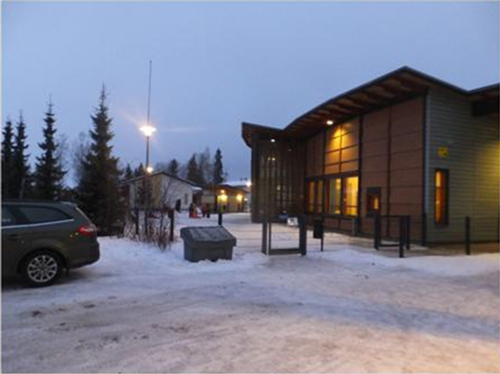 |
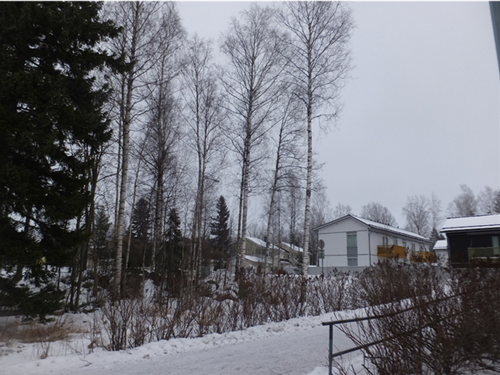 |
|
| Photo 1: Daycare center at 9am in January | Photo 2: Forest across the daycare center |
The daycare center opens at around 6am and closes at around 6pm. Children eat breakfast at around 8am. This facility has an esikoulu (for six-year-olds) within the facility. The number of children enrolled in five classes is 100 in total, while the number of children attending esikoulu is 25. In addition, about 40 children participate only in club activities.
The lessons of esikoulu are provided for four hours per day, from 9am until 1pm. Some children only attend esikoulu according to the circumstances of their parents, while others spend time until late afternoon at the daycare center after the esikoulu lessons.
Daily activities are determined for each grade, focusing on small-group activities. The esikoulu class starts lessons with the entire group of all six-year-olds from 9am every morning (see Photos 3, 4 and 5).
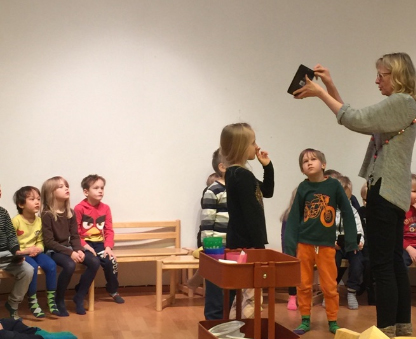 |
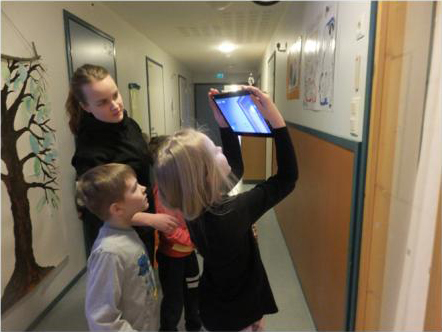 |
|
| Photo 3: Lesson with all six-year-olds in the morning | Photo 4: Children working on their assignments with a tablet |
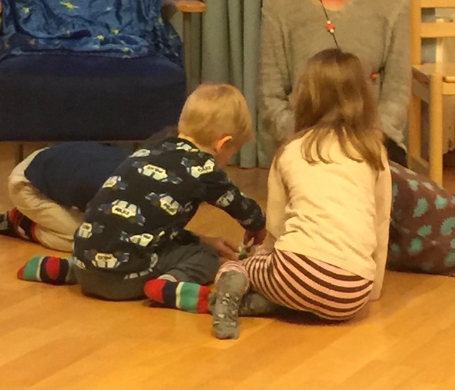
Photo 5: Play with building blocks
First, all children were assembled in a large room and started various activities. When we visited the daycare center, the children were divided into several groups of four or five. Some were working on fun quizzes relating to calculation and figures; some were competing in building toy blocks as tall as they could. Then, a tablet was provided to each group, with which children worked on their assignments (such as "taking a picture of the largest thing within the building"), walking around inside the building and taking photos freely. Finally, they assembled again in the large room and each group gave a presentation. Teachers gave instructions to the children on how to make a presentation. It was impressive that they conducted activities with numbers and classifications, such as counting numbers, identifying even and odd numbers, arranging numbers in descending order, and so on. In addition, their activities with tablets were related to the focused area of the new national core curriculum "ICT (IT) - competence." Children of all groups demonstrated competency in the use of tablets.
After that, the children were divided into small groups and participated in free activities. The facility has a large number of small rooms with specific themes and relevant materials; a room to play board games, a room for painting, a PC room, and a room to play house. Each group of children chose one of the themes for the day, and went to the relevant room to conduct activities (see Photos 6, 7 and 8). Boys rushed into the board game room and played happily with the games. Children are engaged in two types of activities; activities of a certain topic chosen by children for the day, and long-term activities such as creating a piece of work. Photo 9 shows some tie-dyed pen cases made by children, which required six months to complete.
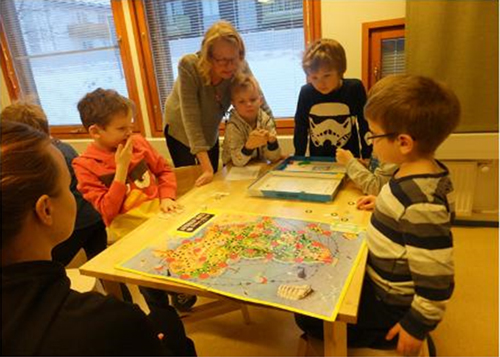 |
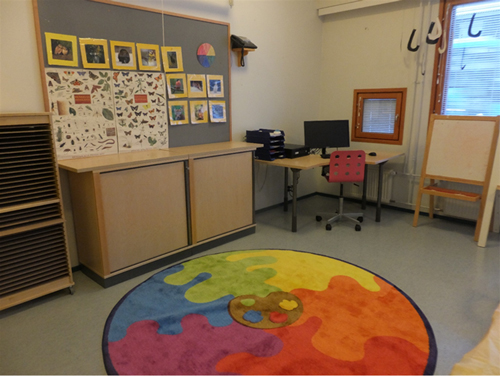 |
|
| Photo 6: Room to play board games | Photo 7: Room for painting |
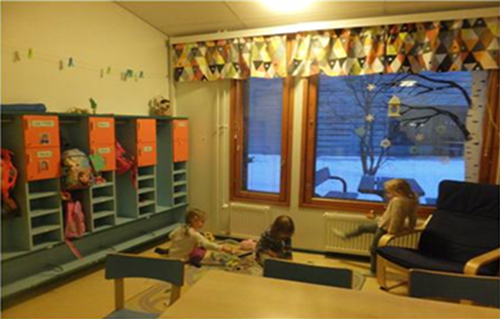 |
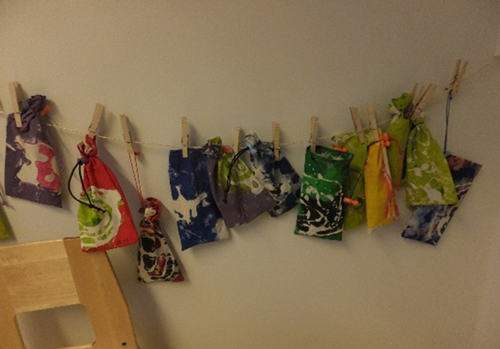 |
|
| Photo 8: Room for little children | Photo 9: Work of children's long-term project: tie-dyed pen cases |
When we had an interview with the director of the facility and asked her what they value most, she replied "To help children acquire the ability to think by themselves." When we observed teachers, we found out that they did not actively give instructions to the children, instead, they carefully watched them, taking a step back. When children have any trouble, teachers first help them think about how to resolve it. In this way, children will learn how to proactively join activities and express their opinions, and develop cooperativeness and autonomy.
2. Daycare Center B: Learning in an environment composed of elementary school, daycare center, and neuvola
The second daycare center we visited is also located in Vantaa City, about 30 minutes by train from the Helsinki Railway Station. Cities around the nearest station were newly developed. The two-story building was just built last year, composed of elementary school, daycare center, esikoulu, neuvola (a Finnish maternity and childrearing support system for families during pregnancy, at childbirth and with children), and a child-rearing support center. The center of the building houses a cafeteria where children of all ages take their meals. The opening and closing hours of the facility are almost the same as those of Daycare center A. The number of children assigned in six classes is 90 in total, and 29 of them attend esikoulu. The facility is open to the public and offers activities for local residents. There are a large number of small classrooms for various activities, all of which are glass-walled so that teachers can observe children's activities (see Photo 11).
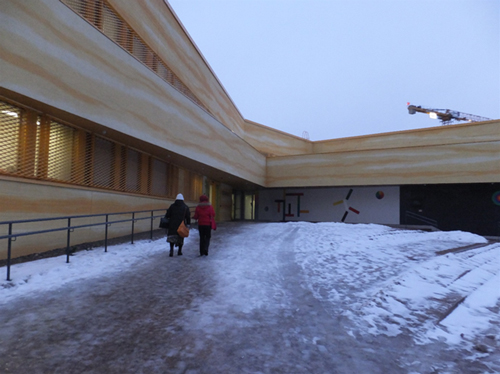
Photo 10: Exterior of Daycare center B
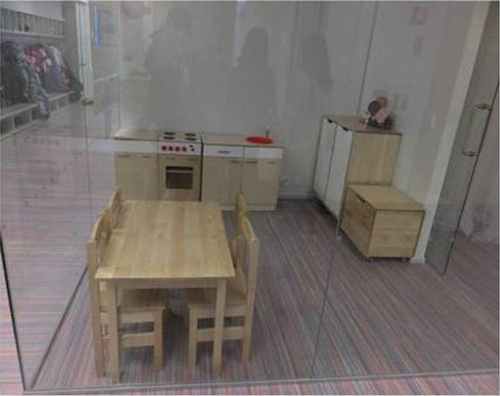 |
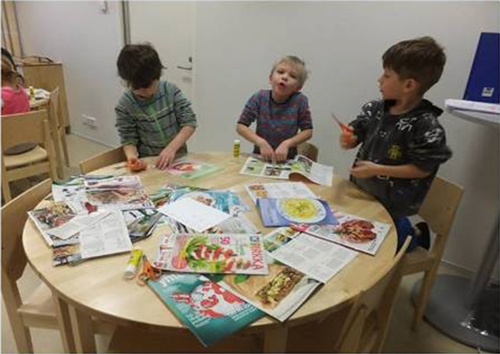 |
|
| Photo 11: Glass-walled room to play house | Photo 12: Children engaged in their activities |
The building was built based on a design selected through a competition in order to realize the education policy of the daycare center. Therefore, it is designed to facilitate interactions between the elementary school and the daycare center. For example, there is a cafeteria in the center of the building to make children feel the reality of spending time together with children of different ages under the same roof. All the classrooms branch out from this cafeteria (see Photo 13). Vacant classrooms can be commonly used, while the Principal's room of the elementary school and the Director's room of the daycare center are connected by a door, allowing easy access between them. Since the building comprises a child-rearing support center, daycare center, esikoulu and elementary school, most of the children have grown accustomed to visiting the building from an early age. This enables parents to anticipate the future development of their child as well as to easily access and establish a relationship with other parents, teachers, and child-rearing support staff members. The daycare center has their original furniture such as desks and chairs made. A movable table that can be used as a chair is made of light material with a simple shape so that children can carry it unassisted (see Photo 14). In addition, the color of walls and floors as well as the layout of furniture are very simple compared to those of daycare centers in Japan (see Photo 15). We asked them why they maintain such a simple interior, and they replied "These rooms can be arranged with colorful works and belongings of children" (see Photo 16). We also saw small Murphy beds (wall beds) for children's napping time (see Photo 17). After observing the facility, we felt that the design of the environment is also critical in realizing educational policies.
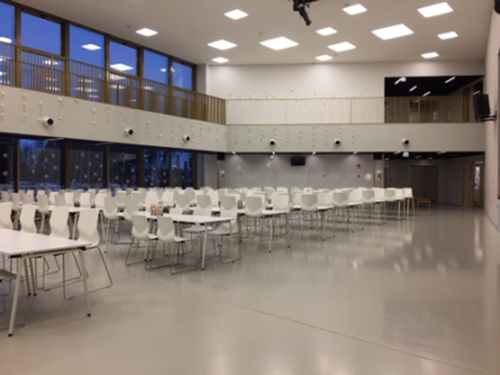 |
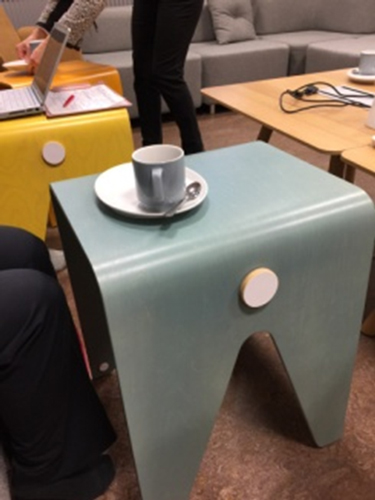 |
|
| Photo 13: Cafeteria | Photo 14: Original table/chair |
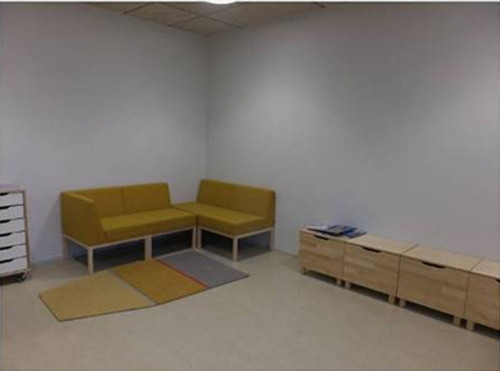 |
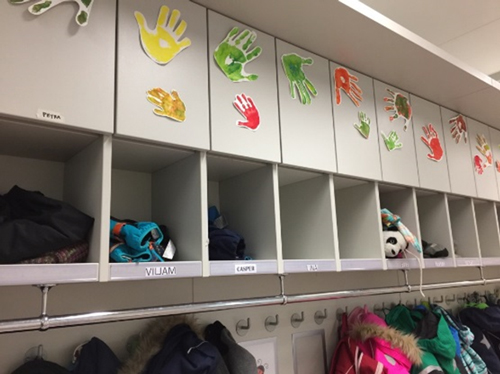 |
|
| Photo 15: Simply designed interior | Photo 16: Colorful works of children |
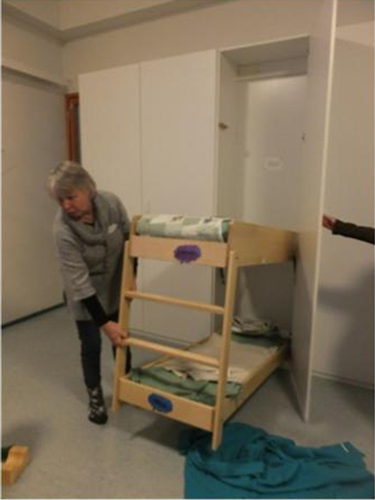
Photo 17: Small wall bed for napping
We asked them how they collaborate with each other to promote interactions between the daycare center and the elementary school, and they said that they do not make special arrangements for class schedules, etc. but try to share some daily activities such as singing a song together. Esikoulu focuses on interactions with parents when their children are at the transition to elementary school and have interviews with them three times before and after their children's enrollment in elementary school. That is, at the time of enrolling in esikoulu, at the time of graduation, and after enrollment in elementary school. Parents consult with teachers regarding what they can do at home and what their child will do at the daycare center, and teachers will provide instructions tailored for the personality of each child. There is no "First-grader problem," one of the current social issues in Japan, where some first-grade children have trouble coping with the changes and gaps between kindergarten and elementary school at the beginning of their school life.
The two daycare centers we visited this time focus on the following four points in terms of child education:
(1) Activities through play that is a pillar of childcare
(2) Attitude of teachers by taking a step back and carefully observing children
(3) Designing of a learning environment
(4) Collaboration with parents
We also asked the teachers what they think about the characteristics of parents in recent years, and they replied that "there are two distinct types of parents: those who positively interact with their child and those who have problems of their own." The reasons for this phenomenon include: diversified family styles and an increasing number of divorced parents; and an increasing number of young families with diminished confidence due to the lack of real child-rearing networks and simple reliance on information from the internet and magazines. Therefore, it is considered necessary to provide an opportunity to build a child-rearing network in local communities, if the grandparents of children are living far away and difficult to reach. Likewise, some parents are worrying about their child's development forcing them to take various enrichment lessons. The director believes that the most important thing for parents is to spend time with their child, and always advises parents, saying that "You just need to be yourself. That's more than enough for your child." In a society where the birthrate is declining and nuclear families are increasing, young parents are confronted with a tenuous child-rearing network and are losing confidence in child-rearing. In this phenomenon, we found some aspects common to Japanese child-rearing. Looking at the good sides, we found that esikoulu plays an important role in the transition from daycare center to elementary school, providing an effective curriculum through play and maintaining close collaboration between parents and teachers, which provides some hints for Japanese childcare workers that they can draw on.
In the next report, we will report on the actual conditions of families in Finland and their parent-child relationships.
The original article in Japanese was reviewed by Ms. Kuniko Shimomura. I would like to take this opportunity to thank her for all her help.
- * Note 1: Welfare State: A welfare state means a state where a nation (society and the government) is responsible for the happiness of the public (welfare). (Quoted from "Child-care and Child-rearing Support in Finland: Focusing on Child-care and Family Policies")
- * Note 2: Key elements of Finnish ECEC in Japanese ECEC --Sameness and difference in ECEC beyond culture (http://www.childresearch.net/projects/ecec/2017_02.html) Child Research Net
- "Child-rearing and Child-care" by Midori Fujii-Niemelä and Mutsuko Takahashi, Akashi Shoten, 2007
- "Key elements of Finnish ECEC in Japanese ECEC --Sameness and difference in ECEC beyond culture" by Chika Inoue and Anne Valpas, Child Research Net, 2017
- "Child-care and Child-rearing Support in Finland: Focusing on Child-care and Family Policies" by Setsuko Ando, vol. 37, Journal of Misono Gakuen Junior College 2007
- "Education that Supports the Development of Children in Finland" by Haruna Yoshikawa, Keiko Ozaki and Tomio Hosobuchi, vol.64, No.2, Journal of Saitama University Faculty of Education 2015
Reference:



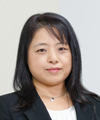 Junko Takaoka, Research Manager/Senior Researcher, Child Sciences and Parenting Research Office, Benesse Educational Research and Development Institute
Junko Takaoka, Research Manager/Senior Researcher, Child Sciences and Parenting Research Office, Benesse Educational Research and Development Institute










